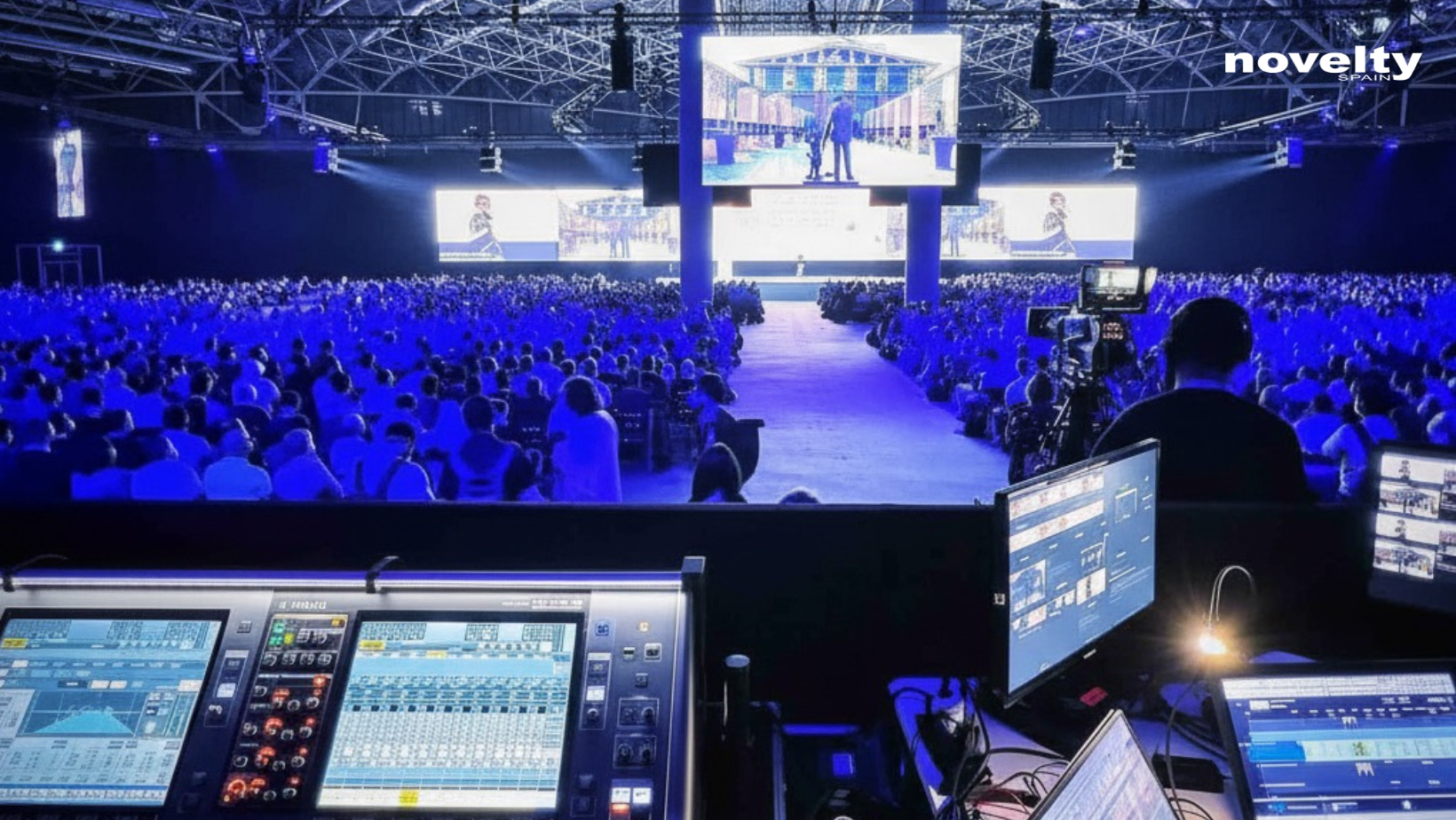- Event AV Services
- Audiovisual Technical Production
- Event Projection Mapping
- Broadcast Services and Live Streaming for Events
- Scenography Design for Events
- Audiovisual Content for Events
- 3D Renders, Interactive Application and VR for Events
- Event AV Services
- AV Consultancy and AV System Integration
- Venue AV Partnership
- AV Equipment Rental
- AV production for events by industry
- AV production by event types
- AV production for venues
- AV Resources
- Global Presence
- Company
- Contact
5 sound management mistakes to avoid at your event
In event planning, there’s one element that can elevate or completely ruin the entire experience. That element is sound management. Often underestimated, sound doesn’t just transmit information — it creates atmosphere, evokes emotions and amplifies the power of your message.
For international agencies and brand managers, ensuring flawless sound is not an option but a technical requirement. From equipment selection to live calibration, every decision affects the final result. In this article, we’ll review the most critical sound management mistakes and how to avoid them to make sure that your event sounds exactly how you imagined.
Mistake 1: ignoring the venue’s acoustics
Before talking about configurations, wattage, or microphones, there’s a key step that often gets overlooked: conducting a technical site visit. This inspection helps identify acoustic limitations, plan ahead for potential issues, and make sure that the sound design is perfectly adapted to the venue’s characteristics.
Assuming that any venue works with any sound equipment is one of the most common errors. Every space has unique acoustics. Hard surfaces, high ceilings, metal structures or even the shape of the room can highly affect how sound is perceived.
Skipping an acoustic assessment often results in unwanted echoes, excessive reverberation, or dead zones where the sound simply doesn’t reach clearly. These issues compromise the audience’s experience and undermine the professionalism of the event, no matter how impressive the visual setup may be.
Mistake 2: choosing the wrong sound equipment
One of the most frequent errors in events of all types is using sound equipment that doesn’t match the venue, the type of presentation or the audience size. The quality of sound depends on coverage, directionality, compatibility with other AV systems and ease of integration, not just power.
For example, a system designed for a concert won’t work the same way at a corporate gala or at a conference with multiple speakers. Every event requires a specific technical solution and sound equipment that complements the context and content.
Underestimating the importance of the right setup can lead to last-minute improvisations, technical failures or a negative impression among event attendees. Choosing well from the start not only prevents problems, but it also dramatically improves the audience’s experience and reinforces your brand’s credibility.
At Novelty, we offer a wide inventory of professional sound equipment for events, offering the highest technical standards to guarantee flawless performance.
Mistake 3: skipping sound checks before the event
A sound check is not a formality but rather a crucial phase in technical production. Skipping it or limiting it to a few minutes before doors open is one of the riskiest and, unfortunately, most common mistakes in corporate events.
Without a full test, sound issues appear at the worst time. These could translate to feedback, background noise, microphones that don’t work, or interference that ruins a key speech — and all in front of a live audience.
Sound checks validate every element of the system from microphones, mixers and outputs to wireless systems, monitors, signal routing and AV synchronisation. Sound check is the time to fine-tune levels, detect issues and simulate real conditions.
A thorough test reduces stress, leaving nothing up to chance.
Mistake 4: not having a backup plan
Even with the best sound management, no event is entirely free from technical surprises. Power failures, interference, faulty connectors or simple human errors can disrupt sound continuity in the middle of an important speech.
That’s why in professional production being prepared for anything is a necessity. Having a backup wireless microphone ready, an auxiliary console configured or a second monitoring system can mark the difference between a flawless event and a technical disaster.
Not having a plan B signals improvisation — something that audiences likely won't forgive. Reliability is a must, especially in corporate events, product launches or international conferences. Thus, it is important to choose an audiovisual partner that guarantees operational security, giving you peace of mind and protecting your brand’s reputation in real time.
Mistake 5: overlooking full audiovisual integration
A very common issue in event production is treating sound, video and lighting as separate systems. In reality, their integration is essential for achieving a cohesive, smooth and technically perfect experience.
When sound isn’t synchronised with visual content — for example, in a video or pre-recorded segment — or when lighting interferes with microphones, the result is a noticeable disconnect that audiences immediately perceive. The same happens if scene transitions aren’t coordinated between technical teams.
Fragmented AV management can lead to timing issues, abrupt cuts or a lack of rhythm during the event. On the other hand, a well-integrated production ensures that every element works together to reinforce the message and better the overall experience.
At Novelty, we approach every event as a complete, interconnected experience. Each technical design considers the interaction between systems from the very beginning — what type of video screen will be used, how lighting affects sound and how the audiovisual setup can enhance the speaker’s presence on stage.
Sound Management Without Room for Error
Avoiding these common sound management mistakes is key to making sure that your event not only sounds great, but also conveys professionalism, precision and technical excellence. The difference between a good event and a memorable one often lies in the details that no one sees… but that everyone hears.
If you want to guarantee an impeccable production, start with the essentials: choose the right partner and rely on high-quality professional equipment. Discover our sound equipment rental solutions with full technical support and international experience now.
Common queries regarding event sound management
The most frequent mistakes include failing to assess the acoustics of the venue, using the wrong equipment, skipping sound checks and not having a technical backup plan. These errors can lead to sound issues such as feedback, echoes or signal loss during the event. Avoiding them ensures a professional, smooth experience.
A sound check allows you to identify and fix technical problems before the event begins, such as unbalanced levels, interference or faulty microphones. It also helps adjust the mix and ensures that all systems (audio, video and lighting) are perfectly synchronised.
This depends on the type of event, the size of the venue and the number of attendees. Generally, a professional sound system with good coverage, directivity and AV compatibility is required. For a tailored solution, you can opt to hire professional sound equipment with technical support, ensuring reliability and quality throughout the event.
The key lies in technical planning: studying the venue’s acoustics, choosing suitable sound equipment, carrying out comprehensive sound checks and having a plan B in place. Partnering with a specialised audiovisual provider guarantees error-free sound management and a flawless experience for attendees.





